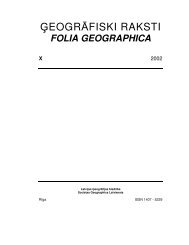eogrÄfiski raksti folia geographica xii - Ä¢eogrÄfijas un Zemes zinÄtņu ...
eogrÄfiski raksti folia geographica xii - Ä¢eogrÄfijas un Zemes zinÄtņu ...
eogrÄfiski raksti folia geographica xii - Ä¢eogrÄfijas un Zemes zinÄtņu ...
You also want an ePaper? Increase the reach of your titles
YUMPU automatically turns print PDFs into web optimized ePapers that Google loves.
HUMAN GEOGRAPHY<br />
the number of people arriving from the metropolitan area to Riga proper did not change much at<br />
all between 1993 and 2000, the number of people departing from the city for other parts of the<br />
metropolitan area increased. During all of the 1990s Riga had a negative migration balance with<br />
cities and towns of all levels, except group of the district centres.<br />
Over the next decade or so, the age of those who are most active in terms of moving from<br />
one place to another will be reached by the generation of people who were born during the one<br />
period in the last half century when Latvia’s residents had the largest number of children, and<br />
that means that processes of active urbanisation should reappear in Latvia. The next trend to be<br />
expected, perhaps, will be an intensive movement toward the suburbs. That would be<br />
determined by a radical reduction in the potential number of people who might want to migrate<br />
from the rural areas. Meanwhile, working people in Riga will have greater expectations and<br />
opport<strong>un</strong>ities to improve their living conditions and living environment.<br />
Trends in the patterns of commuting to work<br />
Wider ranges of jobs as well as higher salaries affect not just the process of population<br />
movement to the city or its surro<strong>un</strong>ding area. It also has an effect on daily commuting patterns<br />
to the area surro<strong>un</strong>ding the city.<br />
Daily commuting has been the object of a variety of studies worldwide. In America, there<br />
has been great focus on the way in which metropolitan areas affect daily commuting [Hamilton<br />
1982, 1989; Gordon et al. 1989]. These authors have argued that everyday commuting in<br />
polycentric and dispersed metropolitan areas takes up less time. Similar results were fo<strong>un</strong>d in a<br />
study of the metropolitan area of Randstad, a town in the western part of the Netherlands [Clark,<br />
Kuijpers-Linde 1994]. In other Dutch studies, however, it has been fo<strong>un</strong>d that the size of the<br />
central city in the region and the level of suburbanisation do not affect the distance of everyday<br />
commuting [Rouwendal, Rietveld 1994].<br />
In Latvia, where the urban system is typified by a mono-centric population structure, it is<br />
precisely the economic factors that play a great role. So do the latest trends in terms of people<br />
wanting to change their way of life and to select their place of residence if their income allows<br />
this. It has to be said, however, that studies of mobility in the Riga metropolitan area confirmed<br />
another aspect of life – many people come to Riga to work, and they then go back home for the<br />
weekend. Rural families face economic survival risks, and they tend to deal with the issue by<br />
“commanding” one family member to go to work in the city. Migrants who move to the city<br />
permanently usually maintain active links to their previous place of residence in the rural areas,<br />
both because their relatives live there and because there are risk factors in the job market [Geyer<br />
2002a].<br />
Although proximity to Riga is generally seen as a promoting factor in small-town<br />
development, it must be noted that in recent years we have seen increasing numbers of people<br />
from the area aro<strong>un</strong>d Riga coming to work in the capital city, because Riga offers better<br />
opport<strong>un</strong>ities to find work, a more extensive offer of places of employment, as well as, on<br />
average, higher salaries. On the other hand, the cost of living in Riga is higher than in small<br />
towns. In Riga, housing prices, as well as rental costs tend to be higher. These conditions<br />
together with the labour market, influence the intensity of daily commuting in the metropolitan<br />
area of Riga. It is also true that many people from the industrial suburbs of Riga now work in<br />
the capital city, because the suburbs were built aro<strong>un</strong>d Soviet-era industrial facilities that were<br />
so narrowly specialized that they lost their markets and can no longer provide work. When these<br />
suburban residents come to Riga to work, they take advantage of the service and retail facilities<br />
of the city. This, in turn, means that specialized service and retail establishments are not being<br />
set up in small towns, because goods and services can be fo<strong>un</strong>d in Riga in a much higher variety<br />
[Bauls, Krišjāne 2000; Krišjāne 2001].<br />
Migration trends show that suburbs are developing, especially aro<strong>un</strong>d Riga. Despite the<br />
fact that its population has declined in the 1990s, Riga remains a city of intensive economic<br />
activity. This belies the generally accepted hypothesis that a positive migration balance is an<br />
indicator of economic growth. This phenomenon can be explained through the fact there is no<br />
longer a need for as intensive a concentration of labour as was the case during the<br />
overdeveloped heavy industry phase of Soviet period, because the structure of the national<br />
70

















